A Citizen Science BioBlitz
Air Date: Week of April 26, 2019
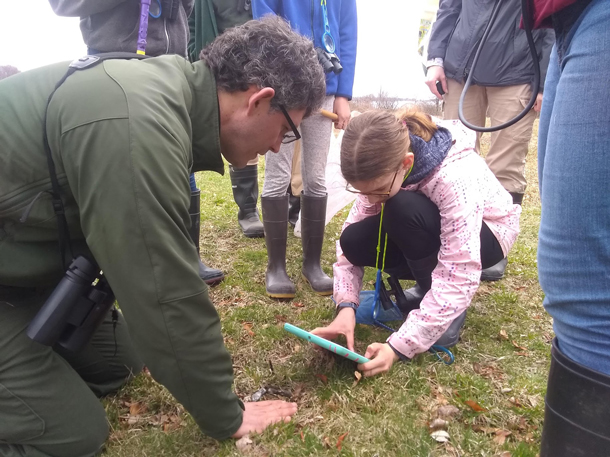
The first observation made on the trip to Thompson Island was made by Marc Albert of the National Park Service. The exciting find was coyote scat, but that didn’t stop the girls from getting up close to photograph it for iNaturalist. (Photo: Courtesy of Colleen Hitchcock)
The City Nature Challenge is an international contest known as a bioblitz: a brief, intensive survey of biological diversity over a set area and time. With a handy smartphone app, anyone can participate between April 26 and 29 by cataloguing the nature in their neighborhoods. Living on Earth's Aynsley O'Neill met up with the Boston BioBlitz Initiative for Girls during a trip to Thompson Island in Boston Harbor, where a group of teens practiced their observational skills for the competition.
Transcript
CURWOOD: Each spring brings the chance for city folks from all over the world to get outside and take part in the City Nature Challenge. It’s a bioblitz competition for people to document nature in their own communities. This year, an estimated 25,000 people, in over 150 cities, are expected to participate between April 26 and May 5. The team that collects the most data gets bragging rights for the year and all of the information collected is uploaded to a database and made available for scientific research. Living on Earth’s Aynsley O’Neill caught a ferry out to the Boston Harbor Islands National Recreation Area with a group of teenage girls. They’re part of the Boston BioBlitz Initiative for Girls, and went to Thompson Island to practice their skills for the challenge.
[BOAT RUMBLE]
O’NEILL: It’s an overcast spring day, but our group of girls is still excited to be heading out to explore the island habitat. There are 10 of us onboard a small ferry boat, 5 teenagers from different Boston public schools, and their educators from Zoo New England, Brandeis University, and the National Park Service.
[FOOTSTEPS]
O’NEILL: On the island the spring thaw and rain mean plenty of mud. Fortunately our guide for the day, Luke Thorson from Thompson Island Outward Bound, has planned ahead.
LUKE: We have some tools that we’re gonna give you that’s gonna help you explore today, help you feel comfortable going out, getting your feet… not wet, but your boots wet.
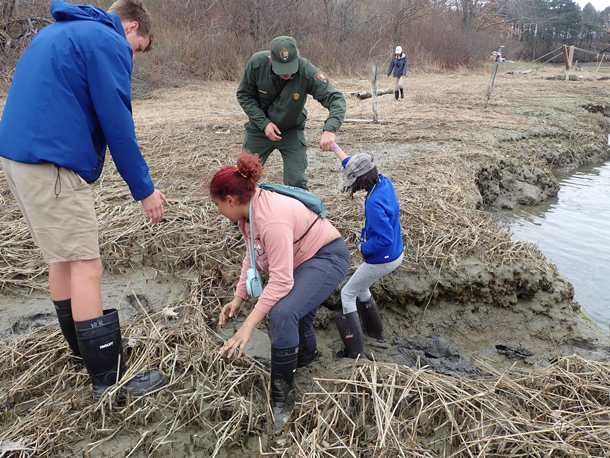
Luke Thorson from Thompson Island Outward Bound (left) Marc Albert from the National Park Service (center) help two of the BioBlitz teens out of a particularly sticky spot in the marsh. (Photo: Courtesy of Colleen Hitchcock)
O’NEILL: This field site on Thompson Island is maintained by the program Outward Bound, and frequently hosts Boston public school students. Luke directs us to a shed where we change into knee-high waders.
LUKE: It is early in the season, so we’re gonna have to do some looking, and get down, and get dirty, and see where things are, meet them where they’re at.
[FOOTSTEPS]
O’NEILL: Luke passes out some field guides and we hit the trail down to the salt marsh.
VOICE #1: What’d you catch?
VOICE #2: It was just a black bug that just, it hopped; it’s not that big.
O’NEILL: As we walk, we spot some bugs and some birds. And we’re hoping to see hermit crabs, oysters, fish maybe. But before we even get to the marsh the girls find something unexpected. Marc Albert from the Park Service, Colleen Hitchcock from Brandeis, and Luke help them identify it.
LUKE: Poop. Coyote poop.
COLLEEN: Scat. Look at that scat, guys.
LUKE: Do you all see that?
MARC: Someone should photograph that!
COLLEEN: Who’s going to iNat that?
VOICE #1: Do you want me to take a picture?
VOICE #2: Yeah, take a picture of it.
COLLEEN: Alright, so remember with iNaturalist, we not only can document things that are alive, we can document things that are dead, and we can document evidence of species. And so, taking a picture of this scat is a great thing to add.
O’NEILL: The girls take a picture and upload it to an online database using an app called iNaturalist where experts will identify whatever’s in the photo.
MARC: And I know this is poop, but it’s mostly hair of animals, so I’m going to touch it with the sticks. I’m just trying to show that there’s bones in here, which’ll make it clear that it’s probably not a dog.
VOICE #1: Coyote?
VOICE #2: Bone in the poopy?
MARC: Bone in the poopy! And look at the photo she was able to take using the magnifying lens.
VOICE #3: Bone in the poopy?
VOICE #2: Bone in the poopy.
VOICE #3: Whoa, there’s a bone in the poopy.
VOICE #4: So you have coyotes on the island?
LUKE: We do.
VOICE #4: That’s so interesting!
LUKE: They appeared here just a few years ago, just a male and female adult that came over, so we have a land bridge that opens up at low tide. So they made their way over, and then they had pups, so they had pups here. And so now we have a family, a grown-up family, that lives somewhere around here. They stay pretty much to themselves.
[FOOTSTEPS]
O’NEILL: When we arrive at the marsh it’s a flurry of activity to get out nets and Petri dishes, and to grab the smartphones and tablets we’ll use to document the species. Within minutes the girls are sifting through water to find plankton, bugs, and perhaps the most hoped-for critter, hermit crabs.
VOICE #1: Oh, a hermit crab! Aah! Success!
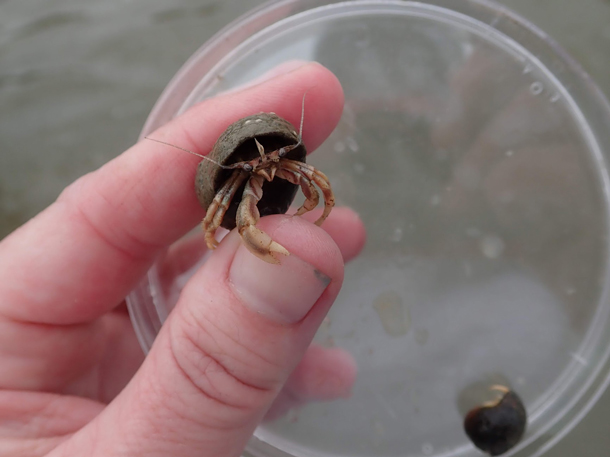
Hermit crabs were one of the favorite finds of the girls. (Photo: Courtesy of Colleen Hitchcock)
VOICE #2: He’s, like, hiding! Should we go do it on iNaturalist?
VOICE #1: Yes.
VOICE #3: We definitely have to iNat that. Yay!
VOICE #2: So cute!
VOICE #4: He’s, like, popping in and out.
VOICE #1: Nice job, Kendra. Okay. Let’s put a little tiny bit of water in there.
VOICE #3: Are you gonna hold it?
VOICE #5: Oh, I can hold it.
VOICE #1: Oh, does any of you want to hold it?
VOICE #3: Definitely should hold it.
VOICE #4: Really tiny!
VOICE #5: Let’s go see how many hermit crabs we can collect and see if we can find the biggest one.
[FOOTSTEPS]
O’NEILL: When we wrap up at the marsh, the sun comes out and we head to the beach to look for native and invasive oysters.
MARC: So we want to go down as low as possible into the low tide area because oysters live underwater basically. They don’t want to be up here where it’s only covered during the high tides. But you can start to see oyster shells already. These are dead oysters, the shells wash up higher. But we ideally want to find some live oysters.
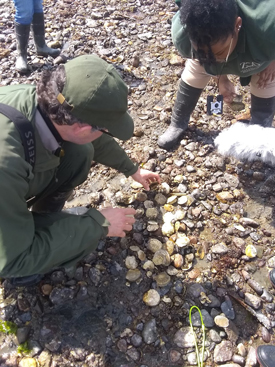
Within a small stretch of Thompson Island’s beach, 26 European Flat Oysters, invasive to the area, were documented. In contrast, in the same stretch of beach, only two native Eastern oysters were found. (Photo: Courtesy of Colleen Hitchcock)
[FOOTSTEPS]
O’NEILL: The oyster data that’s collected from the City Nature Challenge, will help researchers trying to determine the current ratio of native to invasive oysters in this region. The bioblitz team marks off an area and identifies as many oysters as they can find in that space.
VOICE #1: So, one, two, and then three, four, five, six, seven, seven and a half.
MARC: Actually, we found the other species!
VOICE #2: Oh!
MARC: So look at this! So if you open this up, see that purple thumbprint in there?
VOICE #1: Yeah.
MARC: That's an indicator that this is actually the native Eastern oyster.
VOICE #1: Wow, that’s cool!
MARC: And so they very strongly attach to rocks. So that's not surprising that we're seeing this one attached to rocks. But you see, you look inside these other ones, they don't have that same telltale sort of purple thumbprint.
VOICE #1: Wait, so these are the native ones?
MARC: These two are the native ones.
O’NEILL: Eventually, the team finds 26 of the invasive oysters, and just two of the native ones.
[FOOTSTEPS]
O’NEILL: As Thompson Island fades in the distance, I ask the girls what they’ve liked best.
VOICE #1: I think the salt marshes, because that’s when we saw the most life, and it was really fun, like with the boots, and like in the water, and finding all those hermit crabs and everything.
VOICE #2: Well, I also really liked the salt marshes, because we got to, like. I never really paid that close of attention to how much life there was. And I really liked just getting muddy and just exploring.
O’NEILL: And to document the life they’ve seen, the girls log on to iNaturalist. With heads down, huddled around our phones, we must look quite the sight – windswept, muddy, slightly sunburnt, and appreciating nature in our own new-fashioned way.
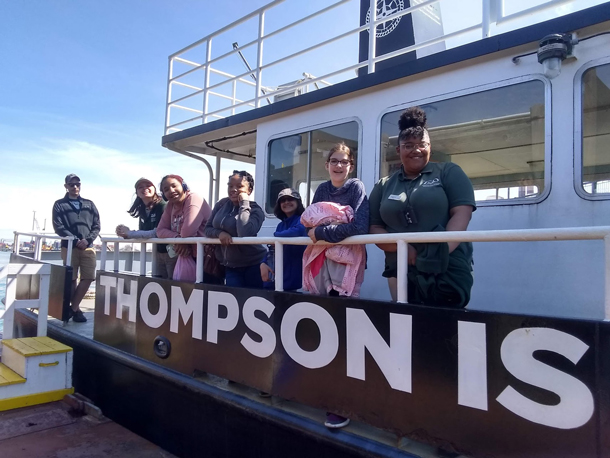
The Boston BioBlitz Initiative for Girls and their chaperones. (Photo: Courtesy of Colleen Hitchcock)
For Living on Earth, from Boston Harbor, I’m Aynsley O’Neill.
[BOAT RUMBLE]
CURWOOD: Data collection for the City Nature Challenge happens April 26 through April 29, and between April 30 and May 5, naturalists will be identifying the observations. If you are a citizen scientist who would like to get involved, you can find out more on our website, LOE.org.
Links
Learn more about the Boston BioBlitz Initiative for Girls
Thompson Island Outward Bound Education Center
Special thanks to the Boston Area City Nature Challenge Steering Committee
Living on Earth wants to hear from you!
Living on Earth
62 Calef Highway, Suite 212
Lee, NH 03861
Telephone: 617-287-4121
E-mail: comments@loe.org
Newsletter [Click here]
Donate to Living on Earth!
Living on Earth is an independent media program and relies entirely on contributions from listeners and institutions supporting public service. Please donate now to preserve an independent environmental voice.
NewsletterLiving on Earth offers a weekly delivery of the show's rundown to your mailbox. Sign up for our newsletter today!
 Sailors For The Sea: Be the change you want to sea.
Sailors For The Sea: Be the change you want to sea.
 The Grantham Foundation for the Protection of the Environment: Committed to protecting and improving the health of the global environment.
The Grantham Foundation for the Protection of the Environment: Committed to protecting and improving the health of the global environment.
 Contribute to Living on Earth and receive, as our gift to you, an archival print of one of Mark Seth Lender's extraordinary wildlife photographs. Follow the link to see Mark's current collection of photographs.
Contribute to Living on Earth and receive, as our gift to you, an archival print of one of Mark Seth Lender's extraordinary wildlife photographs. Follow the link to see Mark's current collection of photographs.
 Buy a signed copy of Mark Seth Lender's book Smeagull the Seagull & support Living on Earth
Buy a signed copy of Mark Seth Lender's book Smeagull the Seagull & support Living on Earth

